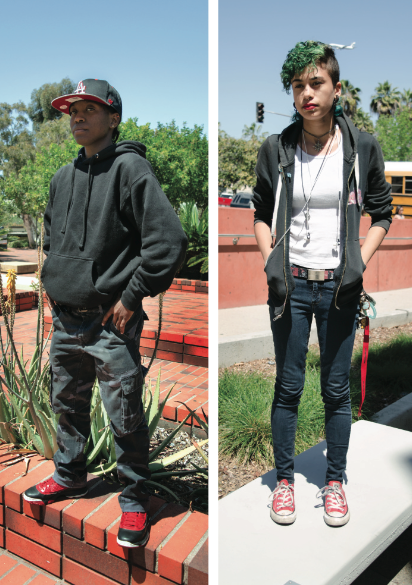Obscuring Gender
Fashion trends that are moving toward subverting the boundaries of gender binaries

Adrienne Mccue (left) is inspired by athletic wear and bases her outfits on what shoes and snapback she decides to wear that day. Alice Kiddo’s style (right) is driven by video games and comic book superheroes such Storm from X-Men, which inspired her androgynous haircut. Photo credit: Richard Lomibao
May 19, 2015
Color broadcast television was introduced in the United States in 1953. By the 1970s, an entire spectrum of coloration imbued the public vision with diversified tones and shades. For the very first time, the concept of heterogeneity was depicted on public television screens. Ironically, many viewers today continue to perceive their reality through a black and white mindset.
Our reality, the society we created, is rendered to exist as a dichotomous world. This black and white screen depicts a dual division among many social aspects and structures, which often portrays one of the two as the dominant one. The classic: good vs. evil, the economic: bourgeoisie and the proletariat, the political: conservative vs. liberal, and the gendered: masculine and feminine.
The notion of a binary reality is well engrained in our social minds, and society lacks, for the most part, the ability to perceive any aspect existing outside the dual categorizations it itself has created.
Often, as individuals, we place ourselves within categories assuming the roles that have been predetermined to fit the description. We place ourselves in these categories rather than creating a category that fits us. We ignore the rest of the colors that constitute the entire spectrum.
Gender, a topic that has caused much political and social controversy in our society, is considered by a majority of individuals to follow the two-fold categorization structure, and subcategories are deemed “unnatural” or blatantly “wrong.” Gender has challenged this concept of “natural” dichotomy in which both sexes are labeled as either masculine or feminine based on their external sex organs.
Based on this misleading assertion, all individuals, both females and males, are expected to assume specific roles and characteristics that society has predisposed for each sex.
Gender, however, cannot be seen through a black and white screen; it is rather a continuum with no particular dominant trait.
Fashion, which is often considered an art of progression and a way of establishing the next trend, can also be an art for change.
Designers like Rick Owens and Yohji Yamamoto have been challenging these notions of gender dichotomy by creating pieces of art that expand traditional silhouettes on the runway. For his A/W 15 collection in February, Owens sent his male models on the runway with pieces that draped around like tunics exposing sensual parts of their body. This collection had a post-apocalyptic, post-gender aesthetic to it.
Androgynous styles have seeped into the streets. Unique individuals are rejecting societal norms and dressing as they will, mixing and blending gendered styles.
We went around City to find a few of the students that represent this call for change. We asked them what inspires their fashion choices and told them to tell us a bit about where they shop.









